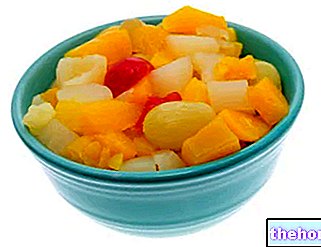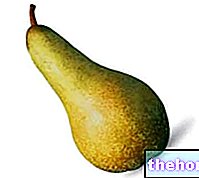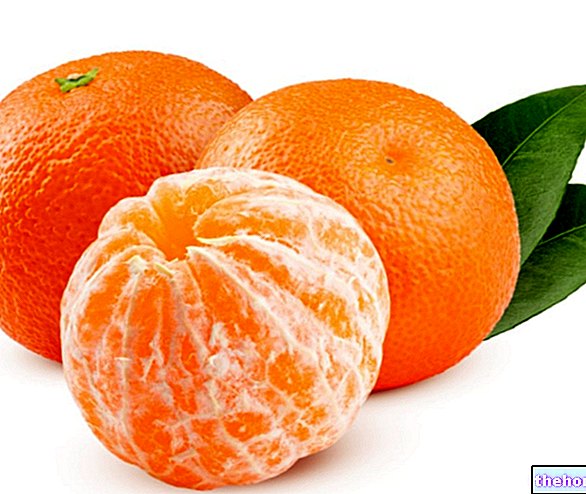
Sweet, acidulous and fragrant, pomegranates have a fairly limited edible portion consisting of a large number of arils - small woody seeds wrapped in a translucent and reddish pulp. The outer shell and internal structures are not edible.
Pomegranates belong to the VII fundamental group of foods - fruits and vegetables rich in vitamin C. They also contain a lot of water, a good amount of fructose, fiber, mineral salts and non-vitamin antioxidants - for example phenolic ones. They are relevant in the vast majority of diets, with a few exceptions mainly related to pre-existing diseases - especially with a strong genetic basis. The seeds contain a small amount of fats and other compounds, but most of them remain intact during digestion and are excreted in the stool.
The pomegranate is eaten mostly shelled and raw, as a dessert or snack. However, it is possible to squeeze it, centrifuge it or extract its juice - see also: Pomegranate Juice and Pomegranate Juice. Arils are also sometimes used as a garnish for sweets or an ingredient in savory recipes - for example in first or second courses.
Considered in the past an esoteric, almost magical fruit, endowed with supernatural powers, recently the pomegranate and its antioxidants have been the focus of various scientific researches. Some have even "alluded" that it can boast anti-cancer properties. If on the one hand it is undeniable that, by virtue of its active ingredients, it can help to hinder oxidative stress, on the other it cannot be considered a remedy or a direct and effective preventive system against the onset of tumors.
The tree that produces the pomegranate is also used for other purposes; for example, there are numerous varieties and cultivars that are exclusively ornamental - called "flowering" or "dwarf". It is however good to keep in mind that the bark of these plants it also provides potentially toxic molecules, therefore not desirable and to be avoided.
Very Easy Pomegranate Juice
Problems with playing the video? Reload the video from youtube.
- Go to the Video Page
- Go to the Video Recipes Section
- Watch the video on youtube
The pulp of pomegranate arils contains a modest amount of calories, mainly supplied by sugars, followed by proteins and finally by lipids; however, water is the most abundant fraction. The carbohydrates of the pomegranate tend to be simple / soluble, consisting of fructose, the proteins have a low biological value and the energy lipids are characterized by a prevalence of unsaturated fatty acids over saturated ones.
The pomegranate does not provide cholesterol, which is replaced by certain steroid phytoelements called phytosterols. Lactose, gluten and histamine do not even appear. The purine content is quite low, as is that of the amino acid phenylalanine.
The pomegranate is a source of minerals such as potassium and phosphorus, although not in particularly high quantities, and secondary levels of sodium, magnesium and iron are not very bioavailable; zinc, manganese and copper are present in traces. The pomegranate contains an excellent level of vitamin C or ascorbic acid and a decent level of provitamin A (retinol equivalent - RAE).
For more information on nutritional details, consult the table in the article: Pomegranate: Nutritional Properties and Use of the Fruit, Beneficial Properties and Toxicity.
You can also find useful information in the description: Pomegranate and Health.
For further information: Pomegranate winter salad or juice, should be limited in nutritional therapy against obesity, type 2 diabetes mellitus and hypertriglyceridemia.On the other hand, the concentration of polyphenols and antioxidant vitamins can help hinder oxidative stress, a crucial aspect in nutritional therapy against various metabolisms, such as hypercholesterolemia, complications of type 2 diabetes mellitus and more.
The abundance of fibers contributes to the achievement of the recommended daily ration, essential for:
- Prevention and treatment of constipation - constipation is related to an increased risk of onset of: hemorrhoids, anal fissures, anal prolapse, diverticulosis, diverticulitis and large intestine cancer
- Modulation of intestinal absorption - reduction of fat absorption, slowing of sugar uptake
- Improvement of the sense of gastric fullness - although we must not forget that fructose, the sugar prevalent in the pomegranate, is the least effective carbohydrate in the metabolic stimulus of satiety
- Prebiosis: nutrition of the intestinal bacterial flora.
The pomegranate has no contraindications in celiac disease, lactose and histamine intolerance; it has no histaminoliberative effect. Even if you do not supply purines in abundance, as it contains a lot of fructose, in case of hyperuricemia it is advisable not to overdo it with sweet fruit - the excess of this nutrient can hinder the elimination of uric acid in the urine. It also lends itself to nutritional therapy against phenylketonuria.
Rich in water and potassium - alkalizing mineral involved in muscle excitability, with a modulation function on blood pressure - the pomegranate is recommended in the diet of those who must maintain the hydrosaline balance - especially compromised, for example in case of sweating from high temperatures or motor activity, or in old age, when the thirst stimulus loses its effectiveness.
Vitamin C (ascorbic acid) is a powerful antioxidant, it is also necessary for the synthesis of collagen and is involved in maintaining the functionality of the immune system. Carotenoids are other powerful antioxidants; moreover, provitamin A plays the role of vitamin precursor of the retinol itself (vit A), necessary for the visual and reproductive function, for cellular differentiation and more.
Pomegranates are suitable for all vegetarian and vegan diets, and for all religious diets. The average portion is 100-200 g of edible portion.
- but also of first and second courses.There are now numerous recipes seasoned with sauces and pomegranate juice, or sautéed with a knob of butter, whole arils and some exotic spice. Furthermore, like apple, orange, pear, plums, medlar and dried fruit or oil seeds, pomegranates also go perfectly with certain meats, such as game or black meat. Fresh pomegranate arils enhance several recipes based on fish, especially raw food - carpaccio, tartar, oyster leaves etc.
Various alcoholic beverages can be flavored with pomegranate, either by adding pure alcohol and sugar to the juice, or by infusing the arils in a mixture of syrup and ethyl alcohol or distillates - such as grappa, vodka, gin etc.
Consult the recipes of Alice, our personal cooker, in the dedicated area: Pomegranate recipes.
Grappa with pomegranate
Problems with playing the video? Reload the video from youtube.
- Go to the Video Page
- Go to the Video Recipes Section
- Watch the video on youtube




























